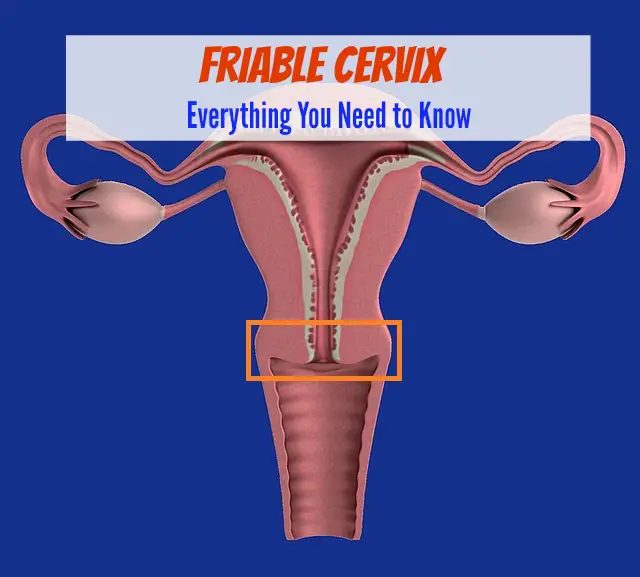According to Web MD, the cervix is a short tube that extends from below the uterus.(1)
Although it is small, it has three highly important purposes to the reproductive system.
Each time that a woman menstruates, the lining of the uterus is shed, since it isn’t needed to support a fertilized egg.
So it flows out of the uterus through the cervix to the female genital organ. It is also where sperm-rich male reproductive fluid flows through to eggs that haven’t been shed with the lining yet.
And if one of the available eggs happens to become fertilized with the sperm, and a baby is carried to full-term, then the cervix will soften and expand to release the infant from the uterus where it will be pushed out of the body through the vaginal canal.
Because of these necessary purposes, the cervix is pliable, firm, and fairly tough. But that doesn’t mean that it is impermeable to damage.
A medical condition called “friable cervix” commonly occurs in sexually active women of all ages, which this article will discuss at great length.
What is a Friable Cervix?
According to Cervical Problems, a friable cervix is a cervix that isn’t healthy.(2)
The tissue is damaged and inflamed, which can cause a woman a great deal of pain during sexual intercourse or menstruation.
There is no medical code to classify this condition because it is more of a collection of symptoms used to diagnose other reproductive problems and diseases that a woman might have.
What Causes This Condition?
 The National Library of Medicine states that there are many conditions that can lead to the development of a friable cervix.(3) The first of them that should be mentioned are sexually transmitted diseases.
The National Library of Medicine states that there are many conditions that can lead to the development of a friable cervix.(3) The first of them that should be mentioned are sexually transmitted diseases.
Trichomoniasis, gonorrhea, HPV, and chlamydia cause lesions over the surface of the cervix that irritate the cells there. If the sexually transmitted diseases aren’t treated in time, they can cause the development of scar tissue, which can cause further problems and pain.
Another condition that causes a friable cervix is natural changes in hormone levels.
As women age, they stop producing as much estrogen. And this causes the cervix to become thin and fragile.
So women who still continue to enjoy an active sexual relationship with their partner often find that the friction of intercourse will lead to damage to their cervix.
Polyps and cysts that are growing near the opening of the cervix can irritate it too, especially if they are very large.
This is usually because tampons or sexual intercourse rub up against them. Some types of malignant and non-malignant tumors have the same effect.
Foreign bodies placed inside the female genital organ can lead to a friable cervix if they are left there too long, such as tampons or other feminine hygiene products designed to prevent menstrual blood from passing through.
They increase the risk of cuts or bruising to the cervix.
MedicalFoxx says that the last cause of a friable cervix is an infection that isn’t related to a sexually transmitted disease.(4)
This most commonly occurs in women who don’t bathe or use the proper forms of hygiene to ensure the cleanliness of the vaginal opening and passage into the body.
And it can also happen if a woman has sexual intercourse with a man whose the male genital organ is covered in bacteria from a lack of hygiene or exposure to fecal matter because the bacteria travels inside of the cervix and surrounding tissue.
What are the Symptoms?
 Pain during intercourse is the most common complaint among women who have a friable cervix.
Pain during intercourse is the most common complaint among women who have a friable cervix.
But depending on the cause of the condition, the pain can sometimes happen even when a woman isn’t sexually active. It can get to be so severe that a woman has no choice but to see a doctor for a medical check-up.
The cervix will also start to bleed, especially if a woman has a sexually transmitted disease.
This symptom presents as spotting in between periods or after sexual intercourse. There might be a yellowish, foul-smelling discharge mixed in with the blood.
Most of the symptoms of a friable cervix can only be seen by a doctor who visually inspects the cervix though.
It will appear red, swollen, and inflamed. Lesions or tears might cover the opening and sides of the cervix. And there could be cysts or tumors growing on it.
What are the Treatment Options Available?
 The treatment options available to women who have this condition depend on what the cause of the friable cervix is.
The treatment options available to women who have this condition depend on what the cause of the friable cervix is.
Large tumors and cysts that are damaging the cervix have to be removed by a surgical operation. If there is cancer present, the cervix and uterus might also have to be taken out with them.
Surgery is also sometimes necessary if the cause of the friable cervix is a foreign object that has become embedded in the body near the cervix.
Emedicine says that if the damage to the cervix is due to an infection or sexually transmitted disease, doctors will prescribe strong antibiotics to clear it up.(5)
They take the time to work though. And a woman who is taking them will still be contagious. So sexual intercourse must be avoided until the doctor can verify that the disease is completely gone.
This can sometimes take up to a month. The partner who infected the woman with the sexually transmitted disease must be treated with antibiotics simultaneously.
Otherwise, they risk passing the disease on to more women. Or they could reinfect the woman who has developed a friable cervix from the disease.
Livestrong says that women who have milder symptoms of a friable cervix because of the hormonal changes of menopause are often prescribed hormone replacement therapy medications by their doctor.(6)
They boost the depleted levels of estrogen and progesterone in the body, so the tissue of the cervix that has become thin and fragile will get thicker and more elastic.
What Should Women do if They Think They Might Have This Condition?
Women who have any of the above mentioned symptoms should not wait to see a doctor.
This condition doesn’t go away on its own, and it can worsen over time. If this happens, there will be more damage done to the cervix.
And any infection that is present could end up spreading throughout the body. The sooner that an appointment is made, the better.
According to Medline Plus, until a woman can get in to see her doctor, tampons or contraceptive devices shouldn’t be inserted into the female genital organ.(7)
This includes spermicidal creams or foams, sponges, or cups designed to block the male reproductive fluid from entering the cervix. Only external methods of absorbing menstrual blood are safe to use with this condition, such as disposable pads.
It is also important to mention that sexual intercourse should be avoided. It will worsen the symptoms of inflammation, pain, and lesions.
And it can increase the likeliness of a woman spreading a sexually transmitted disease to her partner.
Douches should be avoided too, since they can flush bacteria from the female genital organ to the cervix. Bathing with plain tap water is all that is necessary to keep the area clean.
Using soap of any kind can cause more irritation to the cervix.
When is a Doctor Needed?
 Since it takes time for the symptoms of this condition to develop, a woman might not realize that there is anything wrong with her cervix at first.
Since it takes time for the symptoms of this condition to develop, a woman might not realize that there is anything wrong with her cervix at first.
This is problematic because doctors often don’t see women for a friable cervix until there is a significant amount of damage done. So the faster that a woman goes to the doctor, the easier it will be to treat the underlying cause of the condition.
That is why it is crucial that women who have pain during intercourse or spotting that lasts for more than a few days make an appointment with a gynecologist right away.
Those who are having a significant amount of pain should head to the local emergency room instead, especially if they also have a high fever or other signs of an infection.
Conclusion
In conclusion, according to Healthtap, a friable cervix is a serious condition that can affect a woman’s reproductive system.(8) If it is left untreated, it can cause scar tissue to develop, which could affect a woman’s fertility.
It can also lead to the spread of a bacterial infection throughout the body.
Because of this, it is important that all women who are sexually active take the following steps if they start to have the symptoms of this condition:
- Make a doctor’s appointment as soon as possible if sexual intercourse starts to hurt or spotting occurs for more than a few days.
- Go straight to the emergency room if the cervical pain is severe.
- Avoid sexual intercourse until the cervix is completely healed, especially if there is a sexually transmitted disease present.
- Don’t place soap, douches, tampons, or contraceptive devices inside the female genital organ until the doctor says that they are safe to use again because they could cause further irritation to the cervix.
- Always finish the course of antibiotics or other treatment methods that the doctor prescribes. Not finishing them could lead to the condition returning.
References
(1)”webmd.com/women/picture-of-the-cervix
(2)”cervicalproblems.net/friable_cervix/friable_cervix.html
(3)”ncbi.nlm.nih.gov/pmc/articles/PMC3031439/
(4)”medicalfoxx.com/friable-cervix.html
(5)”emedicine.medscape.com/article/253402-treatment
(6)”livestrong.com/article/254483-cervical-changes-during-menopause/
(7)”medlineplus.gov/ency/article/001495.htm
(8)”healthtap.com/user_questions/1182016-what-does-a-hypertrophied-hypervascular-and-friable-cervix-indicate-can-it-b
Leave Feedback: Was this article helpful?

